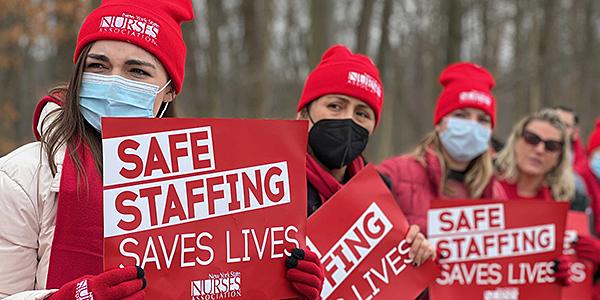NYSNA Works to Ensure Healthcare Workers Have What They Need to Provide Quality Care

I recently testified during a virtual hearing regarding the FY23 Executive Budget. The Governor’s current budget invests significantly in expanding healthcare coverage and capacity, among other things. Since the budget impacts us all, it is important to know where we are and what we are asking of this administration. While I will cover as much as possible in this column, you can see a full list of NYSNA priorities here: bit.ly/budget-priorities.
For the first time in years, NYSNA is not fighting against cuts to the healthcare budget. The Governor’s budget proposals related to healthcare has a goal of increasing the healthcare workforce by 20% over the next five years. This will help the state meet the growing needs of an aging population, expand coverage and access to services, improve the quality of care, and address long-standing racial and socio-economic inequities in access to care and quality of care.
NYSNA welcomes the Governor’s ambitious budget goals. We agree that stabilizing and growing the direct care workforce will be essential in overcoming the current pandemic crisis. The other things that can help is bolstering and restructuring hospitals, nursing homes, and healthcare systems, and meeting the healthcare needs of New Yorkers now and in the future. Unfortunately, many of the concrete policy proposals and funding commitments in the budget are not adequate to fully meet the state’s aspirational goals. We are asking Hochul’s administration to:
1. Expand the RN Workforce via Recruitment, Retention, and Improved Working Conditions
To meet the Executive Budget’s goals of increasing the healthcare workforce by 20%, improving the quality of care, and addressing racial and social inequities in the health system, the state must substantially increase the existing RN workforce.
Nurses are the backbone of the hospital and nursing home sectors, but we are also increasingly in short supply. The nursing shortage is bad and getting worse. The COVID pandemic has stretched the nursing workforce to the breaking point and nurses are leaving or considering leaving the bedside at an accelerating pace. The state can improve recruitment, retention and working conditions if it:
- Fixes the retention bonus proposal to include all nurses (Art. VII, Health and Mental Hygiene, Part D)
- Offers tuition and loan forgiveness for nurses
- Expands nursing school capacity
- Establishes residency and preceptorship programs to support new nurses
- Implements and enforce minimum infectious disease protocols and standards in healthcare workplaces
- Classifies COVID as an occupational disease for Workers Compensation claims filed by front line essential workers
- Improves the Tier 6 pension to recruit and retain nurses in the public sector
2. Improve Nursing Practice and Quality of Patient Care
NYSNA believes that high standards of nursing practice are inextricably interconnected with the quality of patient care in hospitals and nursing homes and are directly correlated to job satisfaction and retention. Frustration with impediments to meeting professional standards of care for patients contributes to staff turnover and the exodus of nurses from the bedside. Accordingly, it is important to maintain nursing scope and practice regulations and resist industry efforts to reduce costs through deskilling and dilution of patient care standards. Towards this end, NYSNA:
- Supports the expansion of Independent Practice Rights for Nurse Practitioners (HMH, Art. VII, Part C)
- Opposes authorizing nursing aides to administer medications (HMH, Article VII, Part C)
- Opposes joining the Interstate Nurse Licensure Compact (HMH, Article VII, Part B)
- Opposes the transfer of oversight of nursing from Higher Education to DOH (HMH, Art. VII, Part G)
3. Ensure Safe Staffing
Ensuring safe staffing in our hospitals, nursing homes and broader healthcare system is a necessary component of addressing inequalities in care, poor patient outcomes and the stability of the healthcare workforce. To improve staffing, the administration must:
- Create a hospital nurse recruitment and retention fund
- Increase doh funding to oversee and implement the new hospital staffing law
- Amend the new hospital staffing law (phl 2805-t) to include additional minimum staffing ratios
4. Expand Healthcare Coverage and Equity
The distorted structure of hospital funding in New York traps safety net hospitals in a perpetual state of financial distress. It makes it difficult if not impossible for them to provide the level of staffing and services that communities need and require. Inadequate safety net funding is also a major contributor to existing racial and class disparities in care and health services. We also note that the level of funding proposed for the Distressed Provider Hospital Fund is not sufficient to break the vicious cycle caused by low reimbursement rates for Medicaid and uninsured patients who rely on safety net hospitals for their care.
In conclusion, we know there is a lot of work to be done. We want to partner with the administration to ensure that healthcare workers have what they need to provide quality care over the long haul. The NY Health Act is the ultimate fix. We are committed to continuing to be a strong voice for patients, healthcare workers and the broader community.

(Above) NYSNA Nurses at Westchester Medical Center and elected officials speak out on February 2, 2022 against facility conditions and the threat to the public’s health; nurses call for a fair contract.